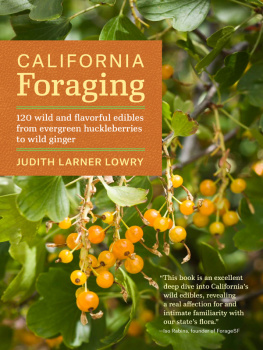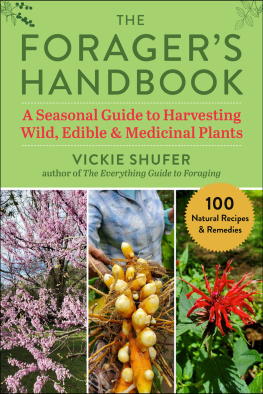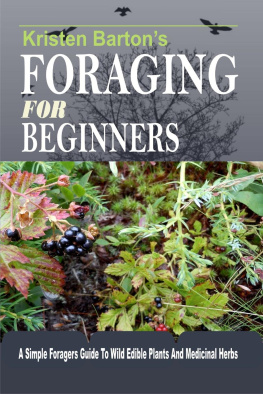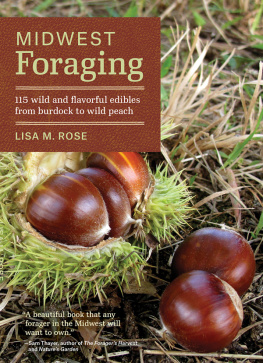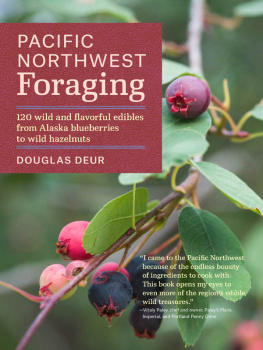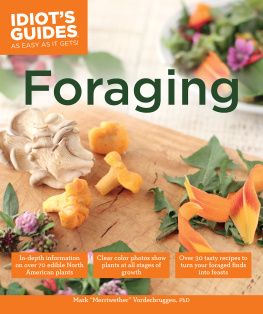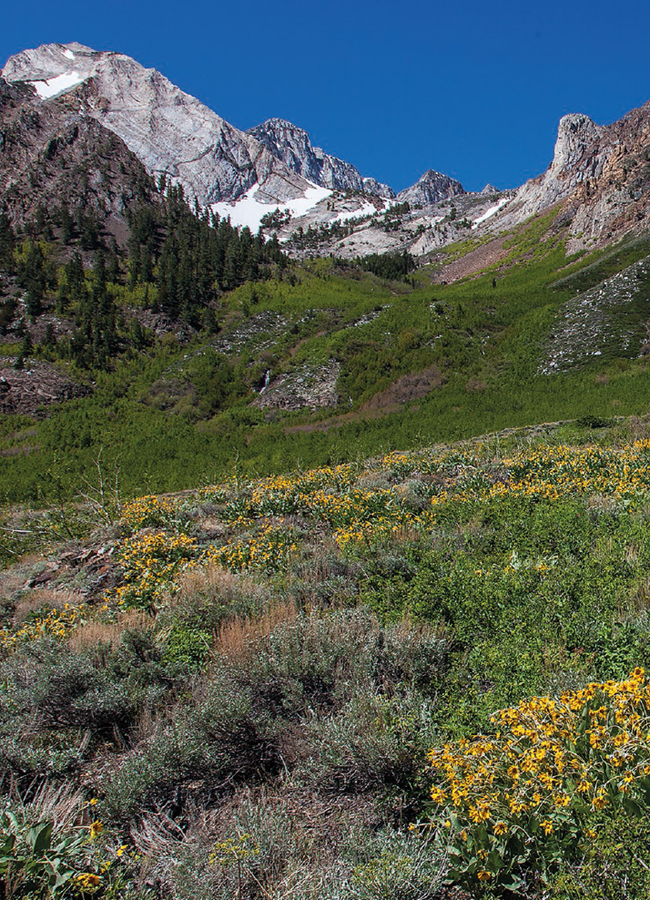
CALIFORNIA Foraging
120 wild and flavorful edibles from evergreen huckleberries to wild ginger
JUDITH LARNER LOWRY
TIMBER PRESS
PortlandLondon
Frontispiece: High meadows of mountain mules ear produce edible seeds and flower stalks within sight of dramatic Sierra Nevada scenery.
The information in this book is true and complete to the best of our knowledge. All recommendations are made without guarantee on the part of the author or Timber Press. The author and publisher disclaim any liability in connection with the use of this information. In particular, eating wild plants is inherently risky. Plants can be easily mistaken and individuals vary in their physiological reactions to plants that are touched or consumed.
Photography credits appear on .
Copyright 2014 by Judith Larner Lowry.
All rights reserved.
Published in 2014 by Timber Press, Inc.
The Haseltine Building
133 S.W. Second Avenue, Suite 450
Portland, Oregon 97204-3527
timberpress.com
6a Lonsdale Road
London NW6 6RD
timberpress.co.uk
Text and cover design by Benjamin Shaykin
Library of Congress Cataloging-in-Publication Data
Lowry, Judith Larner, 1945
California foraging: 120 wild and flavorful edibles from evergreen huckleberries to wild ginger/Judith Larner Lowry.
pages cm
Includes bibliographical references and index.
ISBN 978-1-60469-638-7
1. Plants, EdibleCalifornia. I. Title.
QK98.5.C18L69 2014
581.63209794dc23 | 2013048763 |
To Grayson James Koehler and his parents, Molly and Matt Koehler, and to the memory of Margaret Ellen Grindley, huckleberry pie maker supreme
Contents
Preface
One foggy summer day near the coast, I discovered an unexpected treasure trove of California hazelnut bushes. They were loaded with sweet, mild nuts that were ripe and ready to eat. I found a comfortable place to sit, a rock to crack the shells, and settled in for a session of hazelnut appreciation. To other hikers on the trail, I was hidden from view by the hazels leafy branches.
Soon, I heard two parents cajoling their children onward up the trail. The children sounded tired and complained about being hungry and bored. I thought momentarily of having them join me in my cozy fort under the hazel and sharing the bounty.
While I considered it, they disappeared up the path. Maybe I should have called out to them: There is delicious food here. Come join me.
I didnt then, but I am calling out to you now. There is delicious food all around us.
Two unexpected strands have come together during the writing of this book. One, an even greater deepening of my appreciation for Californias native flora, I expected and welcomed. The other strand has taken me by surprise.
For most of my adult life, I have been an advocate for Californias native plants. At my mail-order native plant seed and nursery business, we specialize in growing seed crops of native wildflowers, grasses, shrubs, and trees, some of them threatened with local extinction.
Through the years, my realization that many of these native plants are also food has felt like startling new information about old friends I thought I knew well. I first started to value Californias native plants for their drought tolerance and appropriateness to Californias climate and soils. Then they became a crucial part of my developing and deepening sense of home in the Golden State, and I wanted to live surrounded by them. Their importance as habitat for native bees, butterflies, birds, and other creatures added yet another layer to my appreciation of the grounding details of sharing life with the plants that evolved here.
Early on, I learned that many of the seeds we gathered from the wild were grain crops for California Indians. The wildflower meadows that drew me with their beauty represented to many native peoples a harvest of healthful seed foods, produced with no added fertilizer, pesticides, water, or plowing. Thats how the journey of this book began, with the seeds.
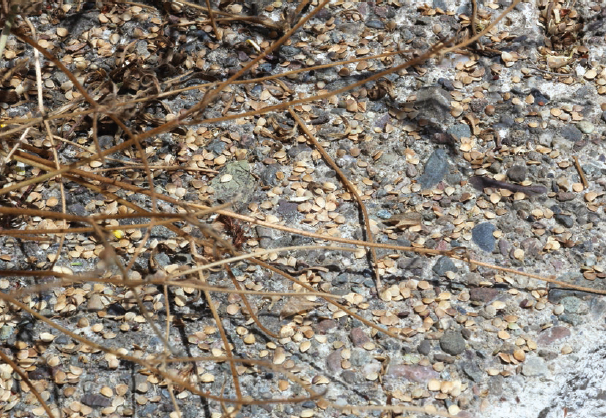
California buttercup flowers dropped their highly edible seeds, prized for making pinole, onto a stone wall, so I could easily brush them into a bag.
When I hear people talk about the importance and value of diversified sustainable farming operations, I look at the wildlands and think about what a diversified sustainable farming operation they already are. Or once were, and could be again.
At our seed-growing garden, I proclaimed a zero-tolerance policy for weeds, the better to learn how the native species grow when unimpeded by teasel, fennel, velvet grass, or other rampant invasive plants. My proclamation of this weed-free zone was made partly in jest, since there is no way to totally eliminate weeds. This I know from experience. But we didnt allow them much of a presence here until my interest in eating naturalized European and Eurasian forbs, otherwise known as weeds, caused me to occasionally stay the weeders hand. The response was surprising, even to me, though I have watched this story so many times before, the old disappearing under the onslaught of the new.
In one season, black nightshade, curly dock, and borage grew where they hadnt been before. Sheep sorrel and chickweed appeared from out of nowhere. Huge colonies of lambsquarters sprang up overnight. The native clarkias, tarweed, and red maids may have been thinking, Oh no, not here, too, as my demonstration garden became a place of somewhat uneasy alliances.
Soon, I was eating these weeds from elsewhere with gusto. Treating weeds as food crops required a close and constant attention and a rigorous control of weedy reproduction. I learned how to have my borage and control it too, making pesto, stews, and stir-fries using a combination of both weedy and native greens. I learned something about the proud histories of weedy greens, especially their roles in intriguing national dishes, like green sauces made in Germany with borage leaves, or salsas made with black nightshade berries in Guatemala.
I began to savor this second strand: harvesting and eating the edible weeds to protect the native plants, while managing and harvesting the native plants in ways that increase their numbers. This pattern now guides my gathering days in the wild. It could be called sustainable foraging, and I hope it will guide yours too.
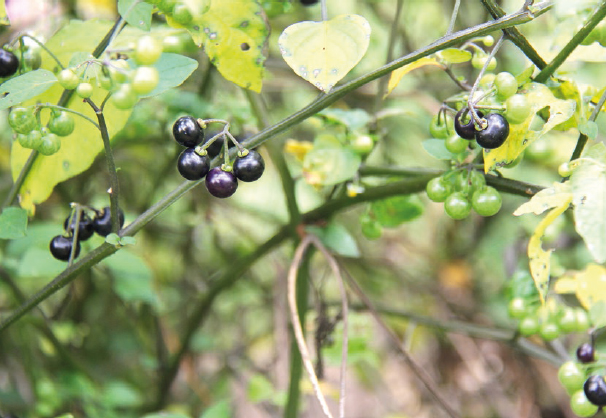
Black nightshade rewards the forager with ripened shiny black berries even while unripe green berries are still present.
By imparting an interest in foraging to you, it is my hope that you will fall in love with wild edibles, their tastes, and their histories, forming alliances and culinary relationships all your own. That you will discover a pattern of interaction that benefits both you and the plants. And that the mantle of indifference toward land and plants that has replaced our evolutionary closeness will slip easily off your shoulders, as you welcome a new, knowledgeable intimacy with wild food plants.
And now a few words about the organization of this book. The introduction provides an understanding of the rich nature of foraging in general, beginning with definitions, and then offering important guidelines, from safety issues to plant identification tips to legal matters. A brief discussion of the regions of California will help you locate both yourself and edible wild plants of interest to you. A Seasonal Gathering Guide will tell you what plant part you can find, when.
Next page
